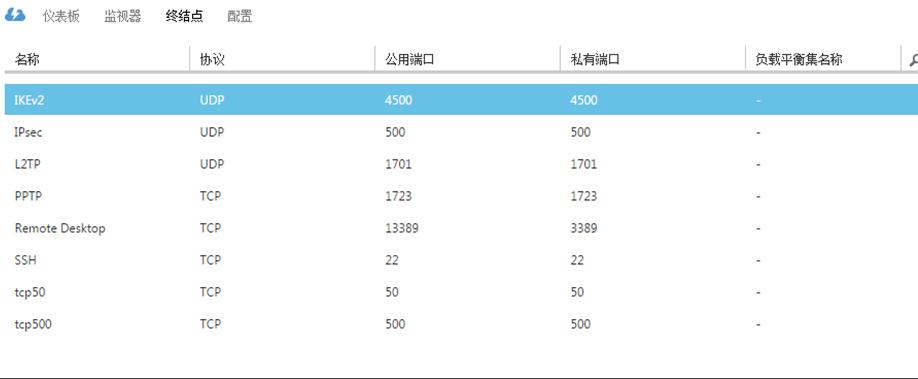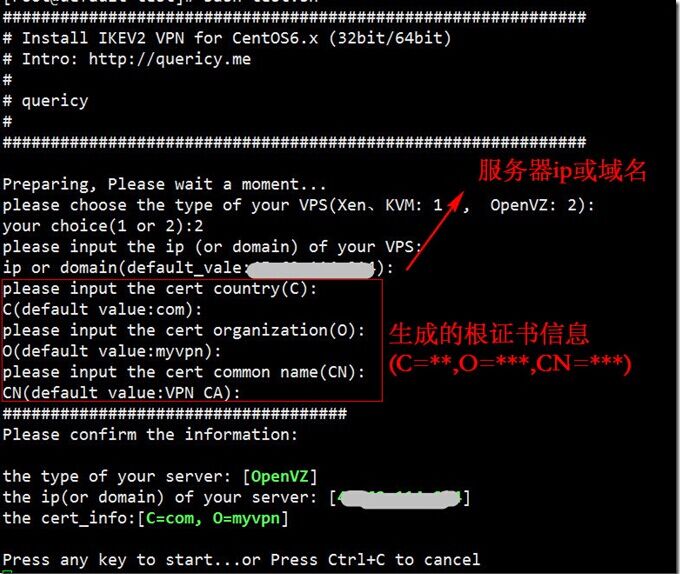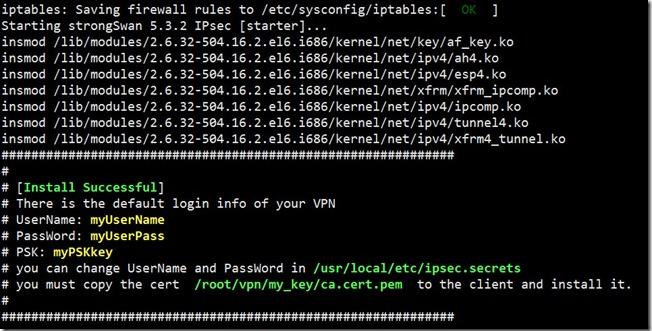1、在azure上创建ubuntu虚拟机 选择v15.04 server 版本
2、添加端口号

3、远程桌面到ubuntu
命令行 输入 sudo su 输入创建 ubuntu虚拟机 时候的 密码
切换到root身份。
4、开始创建 ipsec/ikev2 vpn 服务器
【注】 我选择的是 Xen、KVM 的vps类型
【注】修改后 文件 不生效 则重新启动虚拟机
【注】win7客户端连接vpn 需要证书安装到 计算机账户的 受信任的根证书颁发机构
具体如下:
1.下载脚本:
wget https://raw.githubusercontent.com/quericy/one-key-ikev2-vpn/master/one-key-ikev2.sh
2.运行(如果有需要使用自己已有的根证书,请将私钥命名为ca.cert,将根证书命名为ca.cert.pem,放到脚本的相同目录下再运行该脚本,没有证书的话将自动生成自签名证书咯):
chmod +x one-key-ikev2.sh
bash one-key-ikev2.sh
3.等待自动配置部分内容后,选择vps类型(OpenVZ还是Xen、KVM),选错将无法成功连接,请务必核实服务器的类型。输入服务器ip或者绑定的域名(连接vpn时服务器地址将需要与此保持一致),以及证书的相关信息(C,O,CN),使用自己的根证书的话,C,O,CN的值需要与根证书一致,为空将使用默认值(default value),确认无误后按任意键继续

4.输入两次pkcs12证书的密码(可以为空)

5.看到install success字样即表示安装成功。默认用户名密码将以黄字显示,可根据提示自行修改文件中的用户名密码。(WindowsPhone8.1的用户请将用户名myUserNames修改为%any ,否则可能会由于域的问题无法连接,具体参见http://quericy.me/blog/512文章中的说明)
6.将提示信息中的证书文件ca.cert.pem拷贝到客户端,修改后缀名为.cer后导入。ios设备使用Ikev1无需导入证书,而是需要在连接时输入共享密钥,共享密钥即是提示信息中的黄字PSK.

服务器重启后默认ipsec不会自启动,请自行添加,或使用命令手动开启:
ipsec start
连上服务器后无法链接外网:
vim /etc/sysctl.conf
修改net.ipv4.ip_forward=1后保存并关闭文件 然后使用以下指令刷新sysctl:
sysctl -p
如遇报错信息,请重新打开/etc/syctl并将报错的那些代码用#号注释,保存后再刷新sysctl直至不会报错为止。
bash脚本源码(点击展开)
#! /bin/bash
PATH=/bin:/sbin:/usr/bin:/usr/sbin:/usr/local/bin:/usr/local/sbin:~/bin
export PATH
#===============================================================================================
# System Required: CentOS6.x (32bit/64bit) or Ubuntu
# Description: Install IKEV2 VPN for CentOS and Ubuntu
# Author: quericy
# Intro: http://quericy.me/blog/699
#===============================================================================================
clear
echo "#############################################################"
echo "# Install IKEV2 VPN for CentOS6.x (32bit/64bit) or Ubuntu"
echo "# Intro: http://quericy.me/blog/699"
echo "#"
echo "# Author:quericy"
echo "#"
echo "#############################################################"
echo ""
# Install IKEV2
function install_ikev2(){
rootness
disable_selinux
get_my_ip
get_system
yum_install
pre_install
download_files
setup_strongswan
get_key
configure_ipsec
configure_strongswan
configure_secrets
iptables_set
ipsec start
success_info
}
# Make sure only root can run our script
function rootness(){
if [[ $EUID -ne 0 ]]; then
echo "Error:This script must be run as root!" 1>&2
exit 1
fi
}
# Disable selinux
function disable_selinux(){
if [ -s /etc/selinux/config ] && grep 'SELINUX=enforcing' /etc/selinux/config; then
sed -i 's/SELINUX=enforcing/SELINUX=disabled/g' /etc/selinux/config
setenforce 0
fi
}
# Get IP address of the server
function get_my_ip(){
echo "Preparing, Please wait a moment..."
IP=`curl -s checkip.dyndns.com | cut -d' ' -f 6 | cut -d'<' -f 1`
if [ -z $IP ]; then
IP=`curl -s ifconfig.me/ip`
fi
}
# Ubuntu or CentOS
function get_system(){
get_system_str=`cat /etc/issue`
echo "$get_system_str" |grep -q "CentOS"
if [ $? -eq 0 ]
then
system_str="0"
else
echo "$get_system_str" |grep -q "Ubuntu"
if [ $? -eq 0 ]
then
system_str="1"
else
echo "This Script must be running at the CentOS or Ubuntu!"
exit 1
fi
fi
}
# Pre-installation settings
function pre_install(){
echo "#############################################################"
echo "# Install IKEV2 VPN for CentOS6.x (32bit/64bit) or Ubuntu"
echo "# Intro: http://quericy.me/blog/699"
echo "#"
echo "# Author:quericy"
echo "#"
echo "#############################################################"
echo ""
echo "please choose the type of your VPS(Xen、KVM: 1 , OpenVZ: 2):"
read -p "your choice(1 or 2):" os_choice
if [ "$os_choice" = "1" ]; then
os="1"
os_str="Xen、KVM"
else
if [ "$os_choice" = "2" ]; then
os="2"
os_str="OpenVZ"
else
echo "wrong choice!"
exit 1
fi
fi
echo "please input the ip (or domain) of your VPS:"
read -p "ip or domain(default_vale:${IP}):" vps_ip
if [ "$vps_ip" = "" ]; then
vps_ip=$IP
fi
echo "please input the cert country(C):"
read -p "C(default value:com):" my_cert_c
if [ "$my_cert_c" = "" ]; then
my_cert_c="com"
fi
echo "please input the cert organization(O):"
read -p "O(default value:myvpn):" my_cert_o
if [ "$my_cert_o" = "" ]; then
my_cert_o="myvpn"
fi
echo "please input the cert common name(CN):"
read -p "CN(default value:VPN CA):" my_cert_cn
if [ "$my_cert_cn" = "" ]; then
my_cert_cn="VPN CA"
fi
echo "####################################"
get_char(){
SAVEDSTTY=`stty -g`
stty -echo
stty cbreak
dd if=/dev/tty bs=1 count=1 2> /dev/null
stty -raw
stty echo
stty $SAVEDSTTY
}
echo "Please confirm the information:"
echo ""
echo -e "the type of your server: [\033[32;1m$os_str\033[0m]"
echo -e "the ip(or domain) of your server: [\033[32;1m$vps_ip\033[0m]"
echo -e "the cert_info:[\033[32;1mC=${my_cert_c}, O=${my_cert_o}\033[0m]"
echo ""
echo "Press any key to start...or Press Ctrl+C to cancel"
char=`get_char`
#Current folder
cur_dir=`pwd`
cd $cur_dir
}
#install necessary lib
function yum_install(){
if [ "$system_str" = "0" ]; then
yum -y update
yum -y install pam-devel openssl-devel make gcc
else
apt-get -y update
apt-get -y install libpam0g-dev libssl-dev make gcc
fi
}
# Download strongswan
function download_files(){
if [ -f strongswan.tar.gz ];then
echo -e "strongswan.tar.gz [\033[32;1mfound\033[0m]"
else
if ! wget http://download.strongswan.org/strongswan.tar.gz;then
echo "Failed to download strongswan.tar.gz"
exit 1
fi
fi
tar xzf strongswan.tar.gz
if [ $? -eq 0 ];then
cd $cur_dir/strongswan-*/
else
echo ""
echo "Unzip strongswan.tar.gz failed! Please visit http://quericy.me/blog/699 and contact."
exit 1
fi
}
# configure and install strongswan
function setup_strongswan(){
if [ "$os" = "1" ]; then
./configure --enable-eap-identity --enable-eap-md5 \
--enable-eap-mschapv2 --enable-eap-tls --enable-eap-ttls --enable-eap-peap \
--enable-eap-tnc --enable-eap-dynamic --enable-eap-radius --enable-xauth-eap \
--enable-xauth-pam --enable-dhcp --enable-openssl --enable-addrblock --enable-unity \
--enable-certexpire --enable-radattr --enable-tools --enable-openssl --disable-gmp
else
./configure --enable-eap-identity --enable-eap-md5 \
--enable-eap-mschapv2 --enable-eap-tls --enable-eap-ttls --enable-eap-peap \
--enable-eap-tnc --enable-eap-dynamic --enable-eap-radius --enable-xauth-eap \
--enable-xauth-pam --enable-dhcp --enable-openssl --enable-addrblock --enable-unity \
--enable-certexpire --enable-radattr --enable-tools --enable-openssl --disable-gmp --enable-kernel-libipsec
fi
make; make install
}
# configure cert and key
function get_key(){
cd $cur_dir
if [ -f ca.pem ];then
echo -e "ca.pem [\033[32;1mfound\033[0m]"
else
echo -e "ca.pem [\033[32;1mauto create\032[0m]"
echo "auto create ca.pem ..."
ipsec pki --gen --outform pem > ca.pem
fi
if [ -f ca.cert.pem ];then
echo -e "ca.cert.pem [\033[32;1mfound\033[0m]"
else
echo -e "ca.cert.pem [\032[33;1mauto create\032[0m]"
echo "auto create ca.cert.pem ..."
ipsec pki --self --in ca.pem --dn "C=${my_cert_c}, O=${my_cert_o}, CN=${my_cert_cn}" --ca --outform pem >ca.cert.pem
fi
if [ ! -d my_key ];then
mkdir my_key
fi
mv ca.pem my_key/ca.pem
mv ca.cert.pem my_key/ca.cert.pem
cd my_key
ipsec pki --gen --outform pem > server.pem
ipsec pki --pub --in server.pem | ipsec pki --issue --cacert ca.cert.pem \
--cakey ca.pem --dn "C=${my_cert_c}, O=${my_cert_o}, CN=${vps_ip}" \
--san="${vps_ip}" --flag serverAuth --flag ikeIntermediate \
--outform pem > server.cert.pem
ipsec pki --gen --outform pem > client.pem
ipsec pki --pub --in client.pem | ipsec pki --issue --cacert ca.cert.pem --cakey ca.pem --dn "C=${my_cert_c}, O=${my_cert_o}, CN=VPN Client" --outform pem > client.cert.pem
echo "configure the pkcs12 cert password(Can be empty):"
openssl pkcs12 -export -inkey client.pem -in client.cert.pem -name "client" -certfile ca.cert.pem -caname "${my_cert_cn}" -out client.cert.p12
echo "####################################"
get_char(){
SAVEDSTTY=`stty -g`
stty -echo
stty cbreak
dd if=/dev/tty bs=1 count=1 2> /dev/null
stty -raw
stty echo
stty $SAVEDSTTY
}
echo "Press any key to install ikev2 VPN cert"
cp -r ca.cert.pem /usr/local/etc/ipsec.d/cacerts/
cp -r server.cert.pem /usr/local/etc/ipsec.d/certs/
cp -r server.pem /usr/local/etc/ipsec.d/private/
cp -r client.cert.pem /usr/local/etc/ipsec.d/certs/
cp -r client.pem /usr/local/etc/ipsec.d/private/
}
# configure the ipsec.conf
function configure_ipsec(){
cat > /usr/local/etc/ipsec.conf<<-EOF
config setup
uniqueids=never
conn iOS_cert
keyexchange=ikev1
fragmentation=yes
left=%defaultroute
leftauth=pubkey
leftsubnet=0.0.0.0/0
leftcert=server.cert.pem
right=%any
rightauth=pubkey
rightauth2=xauth
rightsourceip=10.31.2.0/24
rightcert=client.cert.pem
auto=add
conn android_xauth_psk
keyexchange=ikev1
left=%defaultroute
leftauth=psk
leftsubnet=0.0.0.0/0
right=%any
rightauth=psk
rightauth2=xauth
rightsourceip=10.31.2.0/24
auto=add
conn networkmanager-strongswan
keyexchange=ikev2
left=%defaultroute
leftauth=pubkey
leftsubnet=0.0.0.0/0
leftcert=server.cert.pem
right=%any
rightauth=pubkey
rightsourceip=10.31.2.0/24
rightcert=client.cert.pem
auto=add
conn windows7
keyexchange=ikev2
ike=aes256-sha1-modp1024!
rekey=no
left=%defaultroute
leftauth=pubkey
leftsubnet=0.0.0.0/0
leftcert=server.cert.pem
right=%any
rightauth=eap-mschapv2
rightsourceip=10.31.2.0/24
rightsendcert=never
eap_identity=%any
auto=add
EOF
}
# configure the strongswan.conf
function configure_strongswan(){
cat > /usr/local/etc/strongswan.conf<<-EOF
charon {
load_modular = yes
duplicheck.enable = no
compress = yes
plugins {
include strongswan.d/charon/*.conf
}
dns1 = 8.8.8.8
dns2 = 8.8.4.4
nbns1 = 8.8.8.8
nbns2 = 8.8.4.4
}
include strongswan.d/*.conf
EOF
}
# configure the ipsec.secrets
function configure_secrets(){
cat > /usr/local/etc/ipsec.secrets<<-EOF
: RSA server.pem
: PSK "myPSKkey"
: XAUTH "myXAUTHPass"
myUserName %any : EAP "myUserPass"
EOF
}
# iptables set
function iptables_set(){
sysctl -w net.ipv4.ip_forward=1
if [ "$os" = "1" ]; then
iptables -A FORWARD -m state --state RELATED,ESTABLISHED -j ACCEPT
iptables -A FORWARD -s 10.31.0.0/24 -j ACCEPT
iptables -A FORWARD -s 10.31.1.0/24 -j ACCEPT
iptables -A FORWARD -s 10.31.2.0/24 -j ACCEPT
iptables -A INPUT -i eth0 -p esp -j ACCEPT
iptables -A INPUT -i eth0 -p udp --dport 500 -j ACCEPT
iptables -A INPUT -i eth0 -p tcp --dport 500 -j ACCEPT
iptables -A INPUT -i eth0 -p udp --dport 4500 -j ACCEPT
iptables -A INPUT -i eth0 -p udp --dport 1701 -j ACCEPT
iptables -A INPUT -i eth0 -p tcp --dport 1723 -j ACCEPT
iptables -A FORWARD -j REJECT
iptables -t nat -A POSTROUTING -s 10.31.0.0/24 -o eth0 -j MASQUERADE
iptables -t nat -A POSTROUTING -s 10.31.1.0/24 -o eth0 -j MASQUERADE
iptables -t nat -A POSTROUTING -s 10.31.2.0/24 -o eth0 -j MASQUERADE
else
iptables -A FORWARD -m state --state RELATED,ESTABLISHED -j ACCEPT
iptables -A FORWARD -s 10.31.0.0/24 -j ACCEPT
iptables -A FORWARD -s 10.31.1.0/24 -j ACCEPT
iptables -A FORWARD -s 10.31.2.0/24 -j ACCEPT
iptables -A INPUT -i venet0 -p esp -j ACCEPT
iptables -A INPUT -i venet0 -p udp --dport 500 -j ACCEPT
iptables -A INPUT -i venet0 -p tcp --dport 500 -j ACCEPT
iptables -A INPUT -i venet0 -p udp --dport 4500 -j ACCEPT
iptables -A INPUT -i venet0 -p udp --dport 1701 -j ACCEPT
iptables -A INPUT -i venet0 -p tcp --dport 1723 -j ACCEPT
iptables -A FORWARD -j REJECT
iptables -t nat -A POSTROUTING -s 10.31.0.0/24 -o venet0 -j MASQUERADE
iptables -t nat -A POSTROUTING -s 10.31.1.0/24 -o venet0 -j MASQUERADE
iptables -t nat -A POSTROUTING -s 10.31.2.0/24 -o venet0 -j MASQUERADE
fi
if [ "$system_str" = "0" ]; then
service iptables save
else
iptables-save > /etc/iptables.rules
cat > /etc/network/if-up.d/iptables<<EOF
#!/bin/sh
iptables-restore < /etc/iptables.rules
EOF
chmod +x /etc/network/if-up.d/iptables
fi
}
# echo the success info
function success_info(){
echo "#############################################################"
echo -e "#"
echo -e "# [\033[32;1mInstall Successful\033[0m]"
echo -e "# There is the default login info of your VPN"
echo -e "# UserName:\033[33;1m myUserName\033[0m"
echo -e "# PassWord:\033[33;1m myUserPass\033[0m"
echo -e "# PSK:\033[33;1m myPSKkey\033[0m"
echo -e "# you can change UserName and PassWord in\033[32;1m /usr/local/etc/ipsec.secrets\033[0m"
echo -e "# you must copy the cert \033[32;1m ${cur_dir}/my_key/ca.cert.pem \033[0m to the client and install it."
echo -e "#"
echo -e "#############################################################"
echo -e ""
}
# Initialization step
install_ikev2
如需Debian系统的IKEV2一键安装脚本,可参考magic282童鞋的一键脚本:
https://github.com/magic282/One-Key-L2TP-IKEV2-Setup
CentOS/Debian/Ubuntu系统一键安装LNMP/LAMP/LNMPA网站环境:http://www.linuxdiyf.com/linux/13084.html
centos6.5 lnmp、lamp、lnmpa一键安装包:http://www.linuxdiyf.com/linux/12689.html

